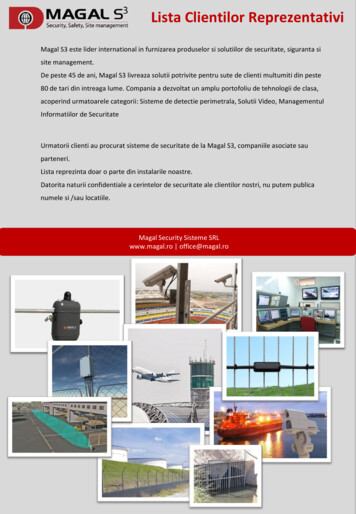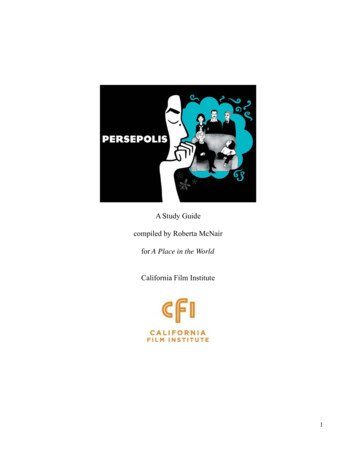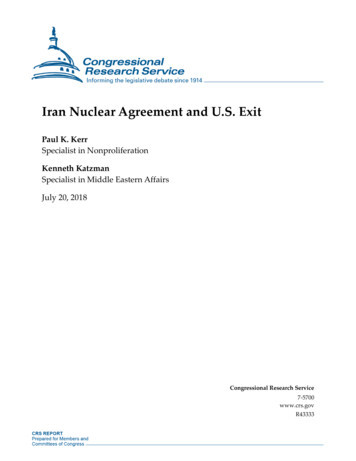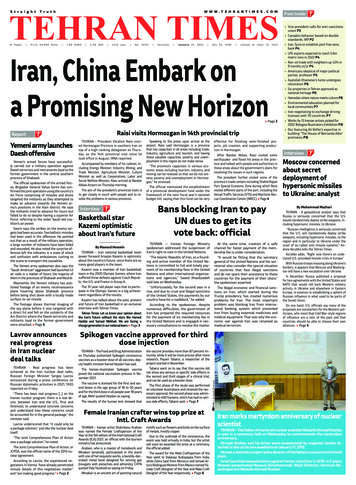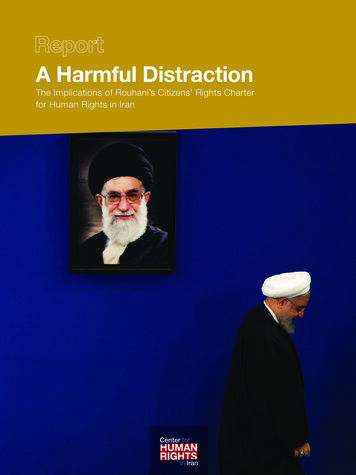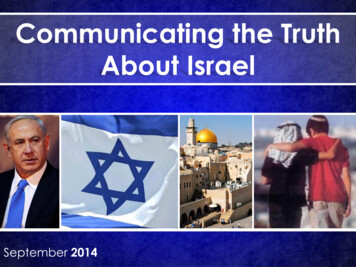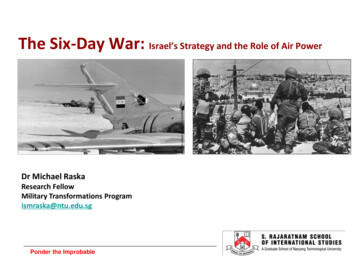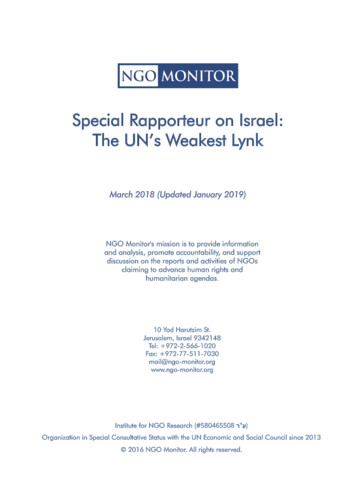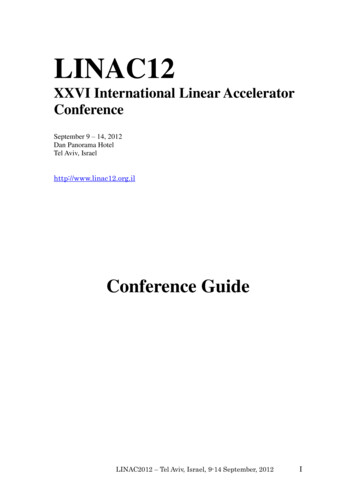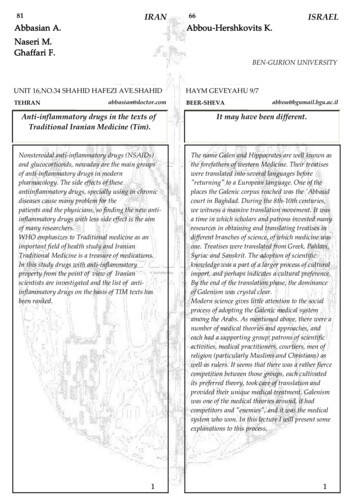
Transcription
81IRANAbbasian A.66ISRAELAbbou-Hershkovits K.Naseri M.Ghaffari F.BEN-GURION UNIVERSITYUNIT 16,NO.34 SHAHID HAFEZI AVE.SHAHIDTEHRANabbasian@doctor.comHAYM GEVEYAHU ory drugs in the texts ofTraditional Iranian Medicine (Tim).It may have been different.Nonsteroidal anti-inflammatory drugs (NSAIDs)and glucocorticoids, nowaday are the main groupsof anti-inflammatory drugs in modernpharmacology. The side effects of theseantiinflammatory drugs, specially using in chronicdiseases cause many problem for thepatients and the physicians, so finding the new antiinflammatory drugs with less side effect is the aimof many researchers.WHO emphasizes to Traditional medicine as animportant field of health study and IranianTraditional Medicine is a treasure of medications.In this study drugs with anti-inflammatoryproperty from the point of view of Iranianscientists are investigated and the list of antiinflammatory drugs on the basis of TIM texts hasbeen ranked.The name Galen and Hippocrates are well known asthe forefathers of western Medicine. Their treatiseswere translated into several languages before"returning" to a European language. One of theplaces the Galenic corpus reached was the 'Abbasidcourt in Baghdad. During the 8th-10th centuries,we witness a massive translation movement. It wasa time in which scholars and patrons invested manyresources in obtaining and translating treatises indifferent branches of science, of which medicine wasone. Treatises were translated from Greek, Pahlavi,Syriac and Sanskrit. The adoption of scientificknowledge was a part of a larger process of culturalimport, and perhaps indicates a cultural preference.By the end of the translation phase, the dominanceof Galenism was crystal clear.Modern science gives little attention to the socialprocess of adopting the Galenic medical systemamong the Arabs. As mentioned above, there were anumber of medical theories and approaches, andeach had a supporting group: patrons of scientificactivities, medical practitioners, courtiers, men ofreligion (particularly Muslims and Christians) aswell as rulers. It seems that there was a rather fiercecompetition between those groups, each cultivatedits preferred theory, took care of translation andprovided their unique medical treatment. Galenismwas one of the medical theories around, it hadcompetitors and "enemies", and it was the medicalsystem who won. In this lecture I will present someexplanations to this process.11
398PALESTINEAbdelaziz Allabadi267Abushwereb A. K.ALQUDS UNIVERSITYABUDIESJERUSALEMLYBIAALFATEH FACULTY OF MEDICINEP.O.BOX 4504aallabadi@med.alquds.eduTRIPOLIdr Abushwereb@yahoo.co.ukPrehistoric medicineCautery treatment for Childhood diseases.The Earth went through very long development andseveral Ages since the –Eolithic Age: after theconsolidation of the Earth to the Paleolithic Agebetween 50,000-12,000 B.C. in which the HomoSapiens developed , to the Mesolithic Agebetween12,000-8000B.C when the NetufianCivilization in Palestine started and the zarzarianin Mesopotamian, and the homo sapiens began tosettle down in small settlements, to the NeolithicAge, with its new inventions in Agriculture andPottery as in the expanding Trade.Humans accumulated knowledge and Experiencethroughout long Periods of Development since theHomo Sapiens, Humans were weak and vulnerableand did not comprehend the Nature Forces aroundthem, so they began to respect and then worshipthem, or to worship certain animals or rivers oranything that have significant Effect on their lives(Taboo).Exorcism was the knowledge or sciencethey believe to help in controlling Nature or healingdiseases.A change in the civilization occurred during theNeolithic Age 8000-4500 B.C. Building of newsettlements, discovery of Agriculture and cattle.Women play an important role in both, whichencourages the domination of female Goddess.Women also may be the first physicians to treat thepain and suffering of their children and husbands.Medicine was mainly of exorcist nature believingthat diseases were generated by Gods or Demons,and healing was achieved by pleasing them.Accumulation of experience about the effect ofcertain plants was also helpful and used by thematerial physici.Cauterization by hot rods is one of the principaltreatment in traditional Arabian medicine , thismethod is still practiced in Libya for the treatmentof many chronic diseases , for adults and children ,in many cities , villages and Bedouin tribes inLibya, the special questionnaire revealed that mostof the cases belong to low socio - economic classfamilies and majority has low standards of healtheducation. Grandmother is the person whocauterize , few cases are left to the traditionalphysician , the skin is touched in certain areas by arod heated in live fire , marks of conterization makespecial design depend on the type , diagnosis andseverity of the disease Rickets , marasmus , acutegastro-enteritis and pneumonia are the mainindications for cauterization in children. Sites are:the chest, abdomen, back and joints in cases ofpainful joints, cauterization is common in hopelesscases of tumors , cancers and hepatomegaly /splenomegaly. Inspite of disappointing results,there is a strong traditional belief that cauterizationcan cure. Complications include: infections,abscesses , scars , keloids, ankylosis and delay insurgical interventions. The author presentsphotographs of real cauterization in childrenshowing special design and markings on the skin.22
157TURKEY137Aksoy S.Aksu M.Kadioglu S.Kadioglu F.Güvercin C. H.Arda B.MEDICAL ETHICS AND HISTORY OFMEDICINE DEPARTMENTHARRAN UNIVERSITY MEDICAL FACULTYSANLIURFAsaksoy@harran.edu.trTURKEYANKARA UNIVERSITYSCHOOL OF MEDICINE, DEONTOLOGY DEPT.ANKARAmaksu001@yahoo.co.ukPhysician-Patient relationship in Italy andin Ottoman empire in middle ages.The village institutes experience of Turkeyand health education.Physician-Patient Relationship (PPR) has alwaysbeen important throughout the history. There havebeen many documents from Ancient Egypt untilpresent times that pictures physicians (or healers)and patients in an examination or a medicalintervention. These pictures give us an opinionabout the status of physicians and patients withrespect to each other.Italy is a special country when we consider thehistory of medicine in middle ages. There were veryspecial institutions and very significant figures inItaly in these ages. It was also the case in OttomanEmpire. There were also monumental health careinstitutions as well as important scholars inOttoman Empire.Roger Frugard (A.D. 13th Century) and SerefeddinSabuncuoglu (A.D. 15th Century) were twofamous physicians of their times who had manysimilarities including having manuscripts onSurgery. In this presentation we compare the PPRin Italy and in Ottoman Empire in middle ages bysearching the medical literature of two countries ingeneral and Roger Frugard’s Chirugia (Surgery)and Serefeddin Sabuncuoglu’s Cerrahiyyet’ulHaniyye (Imperial Surgery), in particular. Ourstudy has indicated that there were similarities aswell as differences in two different traditions thatset examples to the doctors of our time.When the first Turkish Government was foundedduring independent war(1919- 1923), educationwas one of the primary difficulties to receiveattention. The renovation and modernization ofTurkey’s educational system was planned to becarried out by considering our own social andcultural features. Education problems did notneglect even in most critical periods of the war.After the victory the architectures of the newcountry were naturally able to make more energeticeffects to improve Turkey’s much neglectededucational system. One of this enormus effect isexactly the experience of “Köy Enstitüsü” (VillageInstitutes). This project has been reflected therevolutionary character of the Republican Reforms.The education approach of these institutes has beendescribed on the basis of “learning by doing”. Inthis presentation the aspect of health education ofthese institutes is introduced in the light of historyof medicine.33
140TURKEYAlan S.245FRANCEAlbou P.Uzel I.SCHOOL OF NURSINGCUKUROVA UNIVERSITYADANA*13 COURS FLEURUS, INT-AMAND-MONTRONDPaternalism and respect for autonomy inOttoman Medicine.Le laboratoire d’Alzheimer à Munich, ou lanaissance de l’histopathologie moderne ducortex cérébral.The principle of respect for autonomy is one of thecharacteristics of modern medicine. However, in thepast of the medicine paternalistic model has hadbeen valid in patient-physician relationship.Au-delà de la description du cas d’Auguste D., qu’ilprésenta le 3 novembre 1906 à Tübingen, et qui futà l’origine de la « maladie d’Alzheimer », AloisAlzheimer (1864-1915) fut, avec Franz Nissl etquelques autres, au centre d’une évolution décisivedans l’approche histopathologique des étatsdémentiels, à la charnière entre le XIXe et le XXesiècle.In this paper, some Ottoman Medical Books fromXIVth to XVIIth centuries are studied in thecontext of their proposals about the model of patientphysician relationship.A partir de ses recherches et de son enseignementdans le laboratoire d’anatomo-pathologie de laclinique psychiatrique de Munich (laboratoire crééen 1903), Alzheimer aura marqué de son empreintetoute une génération de neuropathologistesprestigieux. Sa carrière et son rôle fondamentaldans le domaine de l’histopathologie cérébraleauraient largement suffi à faire passer son nom à lapostérité même sans la fameuse description de ladémence présénile d’Auguste D. dont tout unchacun connaît l’histoire.44
195GREECEAlexandraki K.372ITALYAliverti M.Alexandrakis A."HYGEIA" HOSPITAL OF ATHENSTHEMISTOKLEOUS 19 MAROUSSI 15122ATENEUNIVERSITÀ DEGLI STUDI DI erti@tiscali.itI fattori che hanno provocato la diffusione ela propagazione della Peste nella Greciamedievale.Un contributo di Enrico Morselli (18521929) sulla fisiopsicologia della suggestione.Le grandi epidemie della peste hanno pesantementeinfluito sulla storia dell' uomo. La peste si 'eintrodotta nell’ Europa dopo la puntura della pulcedi roditori trasportati con la merce da Cina nel 14osecolo. In Grecia 'e arrivato da Constantinopolidopo la sua conquista dall’ impero ottomano.L’ impopolamento di Constantinopoli da personnedi diverse razze humane era la prima causapredispodente alla comparsa della peste. Iltraslocamento di un grosso numero di profughi daConstantinopoli in tutta la Grecia e la loro nuovasituazione socio-economica caratterizzata dalla famee dell’ immiserimento hanno favorito lapropagazione della malattia in tutta la Grecia.Altro fattore di propagazione di questa malattiainfettiva, era il progresso del commercio che portavain relazione i greci con popoli stranieri. Altrofattore sarebbe il basso livello economico finchel’economia appoggiava prevelentemente all’agricoltura. In piu, la comparsa dell’ epidemia sestessa, provocava l’ indebolimento del popolopeggiorando la situazione socio-economica,formando un circolo vizioso. Infatti, l’epidemiaprovocava un gran numero di decessi con riduzionedemografica e conseguente riduzione della personneche potreberro aumentare la produzione rurale ecommerciale e allora portare alla progressionesociale ed economica.Altri fattori facilitanti la propagazione della pesteerano i costumi religiosi o gli scarsi mezzi di Igiene.L’ epidemia della peste nella Grecia medievale 'euno fatto storico che ha dimostrato la strettainterrazione fra il livello socio-economico e sanitariodi una popolozione.Enrico Morselli, nato a Modena nel 1852 e morto aGenova nel 1929, fu una figura importante dellapsichiatria italiana ed europea a cavallo del 1900.Professore di Clinica psichiatrica dapprima a Torinoe poi a Genova, si occupò anche di Criminologia, diAntropologia, di Termalismo e di Psicoterapia.Come altri scienziati positivisti della sua epoca ilMorselli fu attratto dai fenomeni ipnotici emedianici che cercò di studiare secondo i dettamidella moderna psicologia sperimentale. Frutto di taliinteressi appare il lavoro Contributo criticosperimentale alla fisiopatologia della suggestione.Sui fenomeni di credulità per suggestione nonipnotica nelle persone sane apparso sulla “Rivistadi filosofia scientifica” nel settembre del 1890 epubblicato nello stesso anno come “estratto” dallacasa editrice Fratelli Dumolard di Milano. Talecontributo, dedicato al prof. Hippolyte Bernehim(1840-1919) della famosa scuola di ipnosi medicaoperante a Nancy, analizza le varie forme disuggestione capaci di condizionare ilcomportamento di chiunque nelle più comuniattività della vita quotidiana, anche nella completaassenza di turbe psichiche. Nel testo, di unaquarantina di pagine, il Morselli suggerisce inoltrealcuni esperimenti pratici per dimostrare l’effettivapossibilità che un suggestionatore riesca adinfluenzare a suo piacimento chi ha di fronte.Nel suo complesso la suddetta pubblicazionefornisce degli utili spunti per una discussionegenerale sul fenomeno del cosiddetto “placebo”,analizzato in tempi più recenti anche al di fuoridella psichiatria.55
286ITALY56Allegra C.Amar Z.Lippi D.Cianferoni C.Lev E.DIP.ANATOMIA, ISTOL.E MEDICINALEGALE,UNIV.FIRENZE*ISRAELBAR ILAN UNIVERSITYNEVE ZUFF, HALAMISH, D.N. MODIIN ail.biu.ac.ilMedicina e chirurgia nel patrimonioarcheologico toscano.Medicine in Jerusalem during the OttomanPeriod and the Franciscans' medicalactivity.Gli Autori esaminano i reperti di ambito medicochirurgico presenti nelle diverse raccolte toscane. neemerge un panorama estremamente vario ediversificato, sia per la provenienza dei reperti, siaper la loro stessa tipologia.Attraverso queste testimonianze è possibileipotizzare anche un percorso espositivo, chedocumenti l'evoluzione della medicina in territoriocentro-italico, dalla cultura etrusca all'età imoerialeromana.Particolare risalto viene dato agli strumentichirurgici della Collezione Chigi Zandadori delMuseo Archeologico Nazionale di Siena e delMuseo Archeologico di Firenze.For nearly half a century after the Ottomanconquest (1517) the Holy Land began to show signsof recovery and demonstrated appreciabledemographic and economic growth, the product ofthe vigorous rule of a new, efficient administration.Jerusalem achieved a momentum of building andexpansion for the welfare of its residents includingan improvement in the water supply to the city andnew watering troughs. This also had a concomitantimpact, at least for a certain time, in improving thelevel of sanitation and health in Jerusalem. The newconditions also brought growth to the Jewishcommunity in the land, primarily the result ofwaves of immigration from all over the Jewishworld. Among the newcomers were physicians whohad received their medical education at westernuniversities, principally at Padua. Besides thesephysicians, the inhabitants of the holy city weretreated by local doctors and practitioners trained inthe Ottoman Empire in traditional Galeno-Arabmedicine. A few of the doctors functioned as civilservants, others as private physicians. A variety ofuntaught traditional healers practiced medicine aswell (eye healers, blood letters, drug-sellers, etc.).Several welfare institutions operated in Jerusalem,the most important being the general hospitalnamed al-Bimaristan al-Salahi. This was intendedto serve the entire population of Jerusalem, withoutdistinction of religion. This hospital was supportedby the central imperial government or by waqffunds. Out of religious considerations the Jewishand Christian communities preferred to use smallermedical institutions of their own, which wererecognized by the Ottoman rulers.66
80BAKU ARZEBAIJANAmen-zade R.92GREECEAndriopoulos P.Papadopoulos G.Spiropoulos T.INSTITUTE OF ARCHITECTURE AND ART OFAZERBAIJAN67 NEFTYANIKOV AVE, APT 10A, ZIP 370004BAKUZakhundova@karasuopco.comINSTITUTE OF PHARMACOLOGY ATHENSMEDICAL SCHOOLSPORADON 8-10 11361ATHENSpanmar@med.uoa.grWaterworks of medieval Azerbaijan.From laboratory results to meta-analysis:paradigm shift or puzzle solving in currentexperimental medicine.Life-giving strength of water always attracted theattention of mankind and its all the possible usagemethods were developed with a great inventivenessduring the different periods of the history.The introduction of new drugs in medicine ismainly based on molecular studies, isolation ofreceptors and evaluation of experimental results invitro. However, the medical community seems toappreciate their efficiency, usefulness andindications only after well-organized clinicalstudies and meta-analysis of their results. Westudied the introduction of the IIb/IIIa plateletglycoprotein receptor antagonists as an example ofthe meta-analysis model for evaluation of syntheticdrug introduction in clinical medicine in order toassess whether the statistical model constitutes aparadigm shift in Kuhnian terms for experimentalmedicine or it can be considered as a puzzle solvingprocess that strengthens the basic principles ofmodern medicine. The application of the so called“evidence-based medicine” methods - analysis ofstatistical data of well defined clinical settings(including large number of patients and specificevaluation techniques), in our example the use ofIIb/IIIa antagonists in distinct conditions (acutecoronary syndromes, revascularization) withassessment of predefined end points (survival, newevents), is used to overcome the uncertainty ofapplication of laboratory results to clinical grounds.However such a method does not in any wayquestion the validity of the core concept thatmolecular mechanisms are applicable to livingfunctions and can modify the natural history ofdisease. The statistical procedures of evidence-basedmedicine cannot be considered as discontinuity ofmodern medical science, but rather as a puzzlesolving process, leading to a broader appreciation ofcurrent theory.In the East, water was considered to be the mostvaluable and gracious. The masters and craftsmenof the medieval Azerbaijan had striking success inarchitecture of water, the cooling and melodiousstream of which determined the highest emotionalmood of men and decorated the cities.In antroph-amorphous raw the phenomenon“water” was determined by waterworks such askyakhriz, water reservoirs, fountains, ponds,cascades, waterfalls, lashers, mills, bridges, etc. thatentered to the gold fund of the architecture ofAzerbaijan.77
215GREECE219BULGARIAAngelopoulou R.Apostolov M.Lavranos G.Penka I.LAB.OF HISTOLOGY ANDEMBRYOLOGY,MED.SCHOOL, ATH.UNMIKRAS ASIAS 75, GOUDI, 115 27,ATHENSFACULTY OF PUBLIC HEALTH TO THEMEDICAL gBreakthroughs in the history of humanembryology.The naval Doctor Nikola Ispirski and hiscollection ‘Soil from all over the world’.Since the establishment of the first early humansettlements, the occurrence of birth has alwaysfascinated people. As a result, obstetrics was one ofthe first medical fields of expertise to be developed.In the course of years, the study of prenatal life andthe mechanism of labor were intensified, followingthe continuous progress in anatomy and surgery.Hippocrates’ reference to abortions in the medicaloath is indicative of the interest of hiscontemporaries for the events that relate to birth.However, it appears that this long-standing interestwas soon limited, owing to the prevalence of thefemale inferiority doctrine (references found even inAristotle’s work). Throughout the middle ages, thepuritan beliefs that characterized the western worldlead to a standstill in embryology research,surpassed only by the revolutionary work ofWilliam Harvey. At the same time, the introductionof the microscope offered a unique tool for the studyof the organism’s microstructure. Scientistsworking on understanding the way of a completeorganism's creation from a single cell, faced -- fromthe 17th century up to present - -technical,theoretical and cultural difficulties. By supportingnew concepts, such as the theory of epigenesis andthe dogma of preformation, they attempted toanswer a series of questions, some of which remainunsolved mysteries even for our current era ofmolecular approach.The team of authors presents the naval doctor fromVarna Dr. Nikola Ispirski – one of the first navaldoctors in Bulgaria. During his 20 year service hetakes care of the health and the efficiency of thesailors in his capacity as a doctor of a submarinedivision. The authors analyze also his activity as adoctor specialized in transportation traumas and amicrobiologist. They study also his hobby: collectingof soil from all continents.Led by the Latin thought Terra communis materomnium mortalium est /’The Earth is the commonmother of all mortals!’/ Dr. Ispirski puts thebeginnings of his remarkable collection ‘Soil fromall over the world’. In the course of time it isincreased and at the end it consists of over 200exhibits and the owner is called ‘the richest landowner’.His participation is marked also in the VIIIInternational Symposium on Naval Medicine inVarna in October 1978.Key words: naval doctor, doctor of transportationtraumas, collection ‘Soil from all over the world’.88
220BULGARIAApostolov M.362MEXICOAranda A.Penka I.FACULTY OF PUBLIC HEALTH TO THEMEDICAL UNIVERSITY*DEPARTAMENTO DE HISTORIA DE LAMEDICINAGRAL. SÓSTENES ROCHA 73-ASOFIAdonkaslav@abv.bgMÉXICO, D.F.anarc@correo.unam.mxDr. Georgi Ikonomov - The founder of thebulgarian neptune mail.Galenic-Hipocratic Medicine in the XVIcentury mexican colonial Books.The author describes the life and the creativeactivity of Dr. Georgi Ikonomov – the firstBulgarian that has put the beginning of theNeptune mail in Bulgaria 70 years ago. Thebrothers-twins Ikonomovi let the first bottle go inthe river of Strouma when they are hardly at the ageof nine.Emerging still in the ancient times the Neptunemail represents an inseparable part of the history ofnavigation.In 1981 Dr. Georgi Ikonomov decided to surpassthe record of Dr. Taiti from Aberdeen /Scotland/who had succeeded in letting 3000 bottles go in theworld ocean.As a naval doctor and with the assistance of thesailors of the ship ‘Kamchia’, crossing the seasbetween Europe and Africa, Dr. Ikonomov has let4000 bottles go with the description inside of theancient and beautiful Bulgaria, at the same timesending his best wishes to the people who will befinding the bottles.The author has studied and presented a person ofencyclopedic knowledge and research interestsmainly in the sphere of sports medicine, tourism,speleology and the twins. Dr. Georgi Ikonomov hascrossed almost all seas and oceans and realizes hisdreams of childhood that have turned with time intoa realized necessity – to drop into the world oceanthousands of addresses appealing for an ecologicalplanet and humane relations among the people.After sending more than 30 000 bottles the navaldoctor Dr. Georgi Ikonomov receives letters in 16languages from 40 countries and he finds himselfincluded in the Guiness Book of Records.In this work I'm going to review the hipocraticinfluences in the first american medical books andmanuscripts. My interest is understand how thehipocratic theory about the wheater and diet comesto be central in the explication about the NewWorld. To understand that i reviewed the XVIcentury mexican medical books looking forexplications about the sickness, the diferencesbetween the american nature and european natureand difereces about the human constitutios betweenamerican men and european men. I Found that thisbooks contens many references about "epidemics"hipocratic books and also and principal to thehipocratic book "Winds, Waters and places." Justlike exemple I'm going to take the book of Juan deCárdenas, who was a spanish that traveled toMéxico in XVI century and here practiced themedicine and published his book title "SecretosMaravillosos de la Indias", in which he explainedthe caracteristics of the New World climatology,then talk about the humoral constitutions of theamerican natives and the diferences between theyand the spnish man, and also the diferences betweenthe spanish peninsular humoral constitucion andthe spanish who comes to New World, to explainthat Juan de Cárdenas use the Hipocratic theory ofthe "epidemics book" in wich Hipocrates talk aboutthe "Katastasis" or constitucion of a place, and alsoCárdenas taked some galenic explications about thehuman humoral constitutions. This and otherexemples open the posibility to built a diferentinterpretation about the paper and importance ofmedicine in the european kwoledge about the NewWorld and his own interpratati.99
136TURKEYArda B.302ROMANIAArdeleanu M.Aksu M.ANKARA UNIVERSITYSCHOOL OF MEDICINE, DEONTOLOGY DEPT.ANKARAarda@medicine.ankara.edu.trSPITALUL JUDETEAN DE URGENTA "SF. IOANCEL NOU"STR. CIRESILOR NR.1SUCEAVAmihai ard@yahoo.comThe collection of the surgical instruments ofthe deontology Department of AnkaraUniversity School of Medicine.La mëdecine dans une province deRoumanie.The main aim of this presentation is introduce theunique surgical instruments collection of theDeontology Department of Ankara UniversitySchool of Medicine. The Department has beenfounded in 1946 one year after the opening of theSchool of Medicine and the collection is in the sameage with the department. The collection has 200objects which belongs to different historical periods(from Calcolithic Era to Hellenistic Period, fromRoman and Byzantine Periods to Seljucian andOttoman Periods) and has different forms ( pensets,curets, spatulas, excavators ). In thispresentation, that collection will introducesystematically according the fonction and periodwith slides of objects.Le teritoire nommé aujourd’hui la Bucovine ,partajé entre la Roumanie du Nord et l’Ukraine del’Ouest, faisait partie jadis de la Moldavie. Celle-ciest entrée dans l’histoire comme un rempart quidéfendait les couronnes hongroise et polonaisecontre les envahisseurs de l’Est et du Sud. Lespremiers princes régnants sont venus deMaramourech, une province avoisinante, pours’échapper aux engagements de vassalité envers lesrois de la Hongrie. Cela se passait pendant lapremiere moitié du XIV-è siècle. On cite en 1308 le grand voďvode des Moldaves qui futsoigné par de vieilles femmes et puis dans lesmonastères de Putna et de Dragomirna. Dans lamæme période, on peut citer la puissanceguérissante des eaux tout près du monastèrefranciscan de Siret ( l’une des premières capitales dela Moldavie ) et des reliques vénérées du Saint Jean Le Neuf de Suceava. La guérison des maladesétant l’une des obligations de la disciplinemonastique, les monastères abritaient, sans nuldoute, les plus graves malades et encore les pluspauvres d’entre eux. Le premier hôpital endehors d’un monastère a été construit ŕSuceava par le métropolite Anastase Crimca, en1619. Le lieu était près du palais du prince régnant.Pendant ce temps-lŕ, la capitale de laMoldavie était déjŕ a Iassy, mais la ville deSuceava avait son rôle de relais sur routescommerciales, entre la Pologne ( Lemberg, Lyov ) etConstatinople. En 1891, on a commencé laconstruction d’un bâtiment nouveau, ce quiconstitue aujourd’hui la partie vieille del’hôpital départemental de Suceava.1010
246ALGERIAAroua M.ALGERIAAroua N.37 AVENUE MOHAMED ALILET, KOUBA 16050ALGER247mahmoud.aroua@caramail.comAVENUE MD ALILAT, N 37- KOUBA 16050ALGERarouanajet@yahoo.comLa toxicologie dans la medecine arabe:diagnostic et prise en charge.Hygiene et confort dans les bains publicsd'Alger a l'epoque Othomane.Pour avoir un aperçu de la démarche diagnostiqueet thérapeutique en toxicologie dans la médecinearabe, nous nous sommes basés essentiellement surquelques ouvrages célèbres tels que Eddakhira deThabet Ben Kora, El Haoui et El Mansourid’Errazi, Al Quanun fi Tibb d’Ibn Sina, le Teyssird’Ibn Zohr, Akrabadhine Al Valenci, etc. Notreétude est limitée aux intoxications aiguës par voieorale.Rappelons que le traitement moderne d'uneintoxication aiguë comporte trois volets: Laprévention de l'absorption et l'évacuation dutoxique, le traitement symptomatique etl’administration d’antidote. Le souci d'untraitement basé sur ces trois volets existait déjàdans la Médecine Arabe. Ainsi, la conduite à tenircommence par l’énumération des premiers gestes àpratiquer devant une intoxication (vomissements,lavements, purgatifs), puis la classification destoxiques, ensuite le traitement symptomatique, etenfin, un traitement spécifique en fonction dechaque catégorie de toxique, par le thériaque ouantidote.Quatre intérêts se détachent de cette étude : lepremier est d’ordre historique, car il nous renseignesur la toxicologie de l’époque dans la médecinearabe, le second est lié au soucis d’associer untraitement symptomatique au traitementétiologique, le troisième nous fait observer l’ébauchedes premiers gestes de réanimation et enfin, ledernier intérêt nous révèle une démarchediagnostique de la médecine arabe devant uneintoxication qui reste très contemporaine de par leraisonnement et l'attitude thérapeutique.La bibliographie historique signale très peud'équipements hospitaliers à Alger à l'époqueothomane. Cependant, les observateurs de l'époquen'ont pas manqué de noter l'intérêt social desnombreux bains publics que comptait la ville.L'architecture et l'ornementation remarquables deshammams algérois répondaient en effet nonseulement à un besoin d'hygiène mais également deconfort et de détente (musique, massages, boissons).De fait, le hammam jouxtant mosquée, souq et caféétait devenu un élément urbain majeur soulignantl'importance de la vie sociale communautaire etcelle de l'hygiène individuelle et collective en milieuurbain.Le présent article porte sur la descriptionarchitecturale de ces bâtiments, de leuraménagement intérieur, de leurs qualitéstechniques du point de vue du confort thermique etde leur approvisionnement
property from the point of view of Iranian scientists are investigated and the list of anti-inflammatory drugs on the basis of TIM texts has been ranked. Anti-inflammatory drugs in the texts of Traditional Iranian Medicine (Tim). IRAN Abbasian A. Naseri M. UNIT 16,NO.34 SHAHID HAFEZI AVE.SHAHID TEHRAN abbasian@doctor.com Ghaffari F. 81 111
